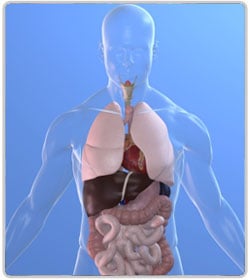Endoscope
An endoscope is a device which is used to perform gastroscopy.
Gastroscopy is performed with an instrument called an endoscope. It has a length of approximately 1200 mm and a diameter of 9.5-12.5 mm. The instrument shaft is composed of numerous specialized glass fibers (>30,000) which allow the transmission of light down the length of each thin fiber with minimal distortion. The multiple fiber optic images are integrated at the proximal eyepiece unit, by means of a complex system of lenses. The endoscopist thus views a reconstructed, mosaic image at the proximal eyepiece (similar to a television image).

Also within the instrument shaft are several separate channels designed for passage of optional devices such as biopsy forceps, polyp snare, cytology brush, cautery or laser device, and suction.
Air may also be introduced for insufflation of the stomach to help in the viewing. A jet stream of water from a separate reservoir can be flushed through one channel for clearing of debris from the viewing area. At the head or handle of the endoscope are two control devices ("wheels") which maneuver the instrument tip as it is advanced, an up-down angle wheel (deflection of almost 180°) and a right-left angle wheel (deflection of 100°). The instrument head is connected with a separate cold light source (usually a halogen lamp) by means of a cable comprised of incoherent fiber-optic bundles (the "umbilical cord"). The water feed tank and automatic suction box also attach to this cable.
Optional accessories include an additional eyepiece for simultaneous viewing by a second operator (the "teaching head"), an ultrasound probe for real time imaging of the stomach wall, pancreas, etc. and photographic or videotape recording devices.










